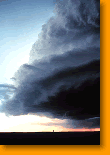
1) WHY does a single cell thunderstorm form?
1) Warm, wet air rises from the ground. At higher altitudes, air pressure is less, the bubble of warm air expands and cools, and its water vapor condenses to form clouds.
2) At the top of the growing thundercloud, the drops of water become large enough to begin to fall down through the rising column of air, and create a downdraft, bringing rain to the ground.
3) Sometimes when the updraft is strong enough, pellets of ice form and keep on growing larger and larger. When they're 5-10 mm across they're heavy enough to fall as "hail": hailstones as large as 140 mm have been reported!
4) In a thunderstorm,
updrafts and downdrafts exist side by side, resulting in violent weather,
and producing the conditions which give birth to both thunder and lightning.
Back to Top

